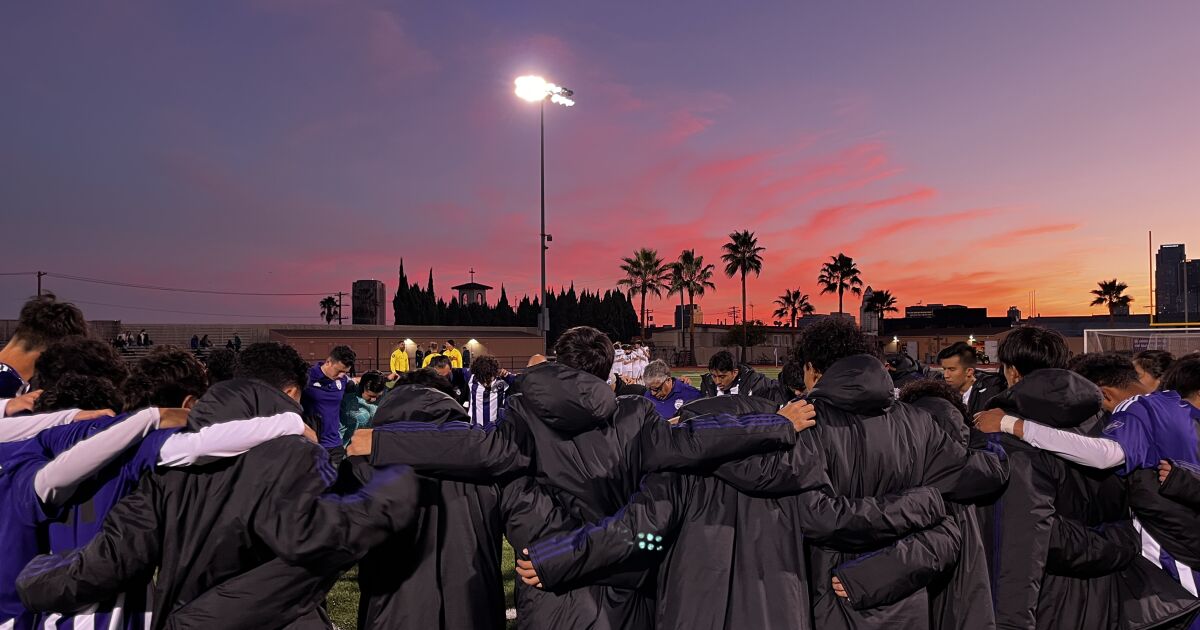Prep soccer: Loyola and Cathedral stay true to international game
The last rays of sunshine glint across the grass. Wisps of orange and pink dance above, intertwining across the Los Angeles skyline, fading behind the concrete jungle that unfurls below Cathedral High’s football field.
The Wilshire Grand Center soars in the east. As night falls, City Hall glows in the distance. This view cherished so dearly by the Cathedral community, the field nestled in the winding hill up to Dodger Stadium, is a sacred slice of Los Angeles.
And the soccer, this blooming downtown rivalry between neighboring Cathedral and Loyola, is a sacred slice of the world.
Over Thanksgiving week, Loyola assistant coach and soccer alumnus Marvin Mires flew to Qatar for the World Cup, representing with a Loyola Soccer shirt. He saw 15 games in six days, taking mass transit around the city while walking roughly 12 miles each day.
His feet blistered. His shins sore. Yet this was a chance to learn, to grow, to study elements of the international game and synthesize them with the Cubs’ style.
Before what’s come to be known as the “Downtown World Cup” on Saturday night, Mires talked to his players about the formation the Netherlands ran in its 3-1 World Cup win over the U.S., the same Loyola’s been using at times to start this season. It’s called a 5-3-2 — five players in the back as opposed to three or four.
“The coach of Holland [Louis Van Gaal], at the end of the game, said, ‘You know, the U.S., they weren’t able to adapt to our system,’” Mires said. “And that was the case, and that’s one of the reasons the U.S. lost.”
Even as Cathedral’s Alexander Bastidas scored a late goal to beat Loyola 1-0, Phantoms coach Arturo Torres admitted Loyola’s five-back formation threw off Cathedral at first. Other elements of the global game were evident Saturday, two programs teaching the value of passing and connecting rather than the longball that dominates U.S. youth soccer.
“I am very big on the development of this game in the U.S., and one of my goals is to try for everyone to play the right way and develop the right way,” Mires said. “Because if the rest of the world is doing it, then why aren’t we doing it, right?”

Cathedral players warm up before taking on downtown rival Loyola on Saturday night.
(Luca Evans / Los Angeles Times)
The Downtown World Cup began in 2018, when Loyola knocked out Cathedral in the state Division I regional playoffs. The game the rivals play is beautiful, Cathedral coach Arturo Torres said, because of its aestheticism.
“We both play a very expansive style of soccer, expansive and forward-minded,” Torres said.
In particular, as high school soccer in the U.S. has increasingly moved toward “kickball,” as Mires put it, Loyola and Cathedral preach passing. Connecting. Valuing possession rather than the home run swings Mires called “archaic.”
“The schools in L.A. — us, Loyola and Salesian as well — we have a certain play style where we move the ball,” Bastidas said. “We don’t just kick it long. We like to play that nice soccer.”
That “nice soccer” is what Mires observed in Qatar as the general trend of the international game. Around the world, Mires said, the game is taught with more play “out of the back,” where nearby defenders make themselves available for short passes from the goalie rather than a long punt downfield.
Not the case at the youth level in the U.S., the Loyola assistant said.
“What’s the end goal of all this — soccer as a country?” Mires said. “It’s for our country to compete and win a World Cup, right? And everyone’s gotta be on the same page, starting from the U7s and the U8s all the way through college.
“But we’re not there as a country to have an identity and a culture of how things should be played.”
That identity, that culture, is taught at Cathedral and Loyola. Players tried the occasional long kick Saturday night, but the game turned into a defensive battle, the two schools fighting for control.
Not a dangerous shot was registered in the first half. Loyola’s five-back formation, Torres said, had Cathedral scrambling to adjust, and the game opened up in the second half as the Cubs began to dominate possession and generate downfield looks.

Cathedral coach Arturo Torres watches from the sideline as his Phantoms and rival Cubs players battle for control of the ball.
(Luca Evans / Los Angeles Times)
It was a strategy that they hadn’t seen before from Loyola, Torres said, a new concept evident of the international game’s influence.
“What you’re seeing is a lot of formational, tactical changes, which is quite intriguing as a coach,” Torres said. “It definitely makes you think about, ‘OK, well, what’s the next wave?’”
Cathedral, though, battled back, beginning to break through the Loyola defense down the sidelines for back-to-back-to-back corner kicks at one point in the second half. In the 80th minute, Bastidas found an opening, cut through the middle and buried a kick in the left corner of the net, the entire Cathedral team running from the bench to mob him on the sidelines.
Cathedral’s passing, Torres said, is innate. It’s long been the way they’ve coached, even as other Southern Section Division 1 programs have moved to more aggressive play. It’s what makes both programs special, Mires said, teaching that system of cohesion rather than chaos.
“Not every school,” Bastidas said of the programs’ styles, “could pull it off.”
For all the latest Sports News Click Here
For the latest news and updates, follow us on Google News.

